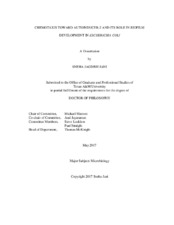| dc.description.abstract | Bacteria navigate within their environment in response to gradients of several environmental cues, including nutrients, toxins, pH, temperature and oxygen. Recent studies demonstrate that Escherichia coli also senses signaling molecules, including the bacterial interspecies autoinducer-2 (AI-2). Such signals are likely to be encountered in the microenvironments inhabited by E. coli and can affect niche localization and colonization. AI-2 also affects biofilm formation and architecture in E. coli. In this study, I explore the role of AI-2 chemotaxis in biofilm formation. Using fluorescence microscopy and crystal violet assays for quantifying attached biomass, I show that, under static conditions, wild-type E. coli RP437 cells rapidly aggregate to initiate formation of surface-attached biofilms. Strains lacking either of the components required to sense AI-2, the binding protein LsrB and the chemoreceptor Tsr, make this transition at a slower rate. These results suggest that chemotaxis toward self-produced AI-2 enhances initial aggregation, thereby contributing to quorum-sensing dependent biofilm formation. In in vitro chemotaxis assays, the response to an external AI-2 gradient is independent of self-produced AI-2. Furthermore, cells require a very small amount of LsrB (~ 50-70 molecules per cell) to exhibit this response. These results suggest that cells are able to respond to non-self AI-2 without requiring induction of the AI-2 uptake system, which only occurs at higher cell density. In conclusion, our results suggest that AI-2 chemotaxis allows E. coli to swim to an AI-2 source generated by the same or other species, to aggregate at that source, and to initiate biofilm formation. | en |


